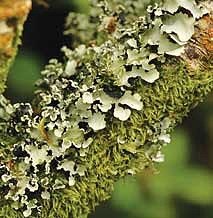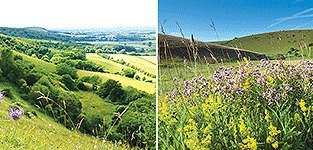West Sussex Wildlife Trust: Lichens
January 1st, 2018 The health of our parish can be monitored by a group of amazing organisms which, though they’re all around us, largely go unnoticed; lichens.
The health of our parish can be monitored by a group of amazing organisms which, though they’re all around us, largely go unnoticed; lichens. At the start of the New Year we’ll be relying on bathroom scales and belt buckles to tell us how our health has fared over the festive period. Meanwhile the health of our parish can be monitored by a group of amazing organisms which, though they’re all around us, largely go unnoticed; lichens.
Lichens are the Banksys of the natural world and bring their anarchic wildlife graffiti into our unnatural rural and suburban landscapes; disrupting the dull uniformity of brickwork and concrete with a dazzling diverse range of patterns, shapes, textures and colours.
Considering that lichens cover 8% of the land’s surface it’s amazing that we hardly notice them but next time you’re out stop and look around. You’ll be overwhelmed – lichens are everywhere. Luminous yellow and orange crusts radiate across roofs, walls, benches and fences. The bare branches and bark of trees are festooned with green lichen lobes. Even the concrete and the clay beneath your feet is covered with the white splodges of lichens which resemble trampled chewing gum.
Once you start looking an invisible world of lichens will materialise and you’ll feel like grabbing the nearest person by the lapels and, wild-eyed, yell 'They’re everywhere– can’t you see? We’ve been invaded!'
The secret behind their success is that each lichen is made of two different organisms – a fungus and an alga. The alga can photosynthesise and provides the food that fuels the fungus while the fungus gives the structure and protection which allows the alga to function. The fungus is the Lennon to the alga’s McCartney; working together they create something amazing and enduring.
Because lichens absorb their water and nutrients through their surface they don’t require roots. This gives them the freedom to simply anchor themselves to any firm foundation; rock, wood, bone, concrete, glass, canvas, metal. They can also withstand severe desiccation. In periods without water they simply switch off. When re-hydrated they spring back to life like the Wicked Witch of the West in reverse.
This versatility and resilience means lichens can survive anywhere on our planet – and experiments have shown they’d probably do alright elsewhere too. They recently achieved remarkable results in the Mars Simulation Laboratory and some folk claim that lichens could be the key to the human colonisation of the Red Planet.
Back on Earth their reliance on rainwater means that lichens are famously sensitive to air pollutants dissolved in rain. The presence or absence of certain lichens is a good indicator of pollution levels. What’s good for their health is good for ours. So get out of the house and into the countryside in January, join the lichens and breathe in some fresh air.
by Michael Blencowe of the Sussex Wildlife Trust
Sussex Wildlife Trust is an independent registered charity caring for wildlife and habitats throughout Sussex. Founded in 1961, we have worked with local people for over half a century to make Sussex richer in wildlife.
We rely on the support of our members to help protect our rich natural heritage. Please consider supporting our work. As a member you will be invited to join Michael Blencowe on our regular wildlife walks and also enjoy free events, discounts on wildlife courses, Wildlife magazine and our guide book, Discovering Wildlife in Sussex. It’s easy to join online at www.sussexwildlifetrust.org.uk/join or T: 01273 497532.
Lichens are the Banksys of the natural world and bring their anarchic wildlife graffiti into our unnatural rural and suburban landscapes; disrupting the dull uniformity of brickwork and concrete with a dazzling diverse range of patterns, shapes, textures and colours.
Considering that lichens cover 8% of the land’s surface it’s amazing that we hardly notice them but next time you’re out stop and look around. You’ll be overwhelmed – lichens are everywhere. Luminous yellow and orange crusts radiate across roofs, walls, benches and fences. The bare branches and bark of trees are festooned with green lichen lobes. Even the concrete and the clay beneath your feet is covered with the white splodges of lichens which resemble trampled chewing gum.
Once you start looking an invisible world of lichens will materialise and you’ll feel like grabbing the nearest person by the lapels and, wild-eyed, yell 'They’re everywhere– can’t you see? We’ve been invaded!'
The secret behind their success is that each lichen is made of two different organisms – a fungus and an alga. The alga can photosynthesise and provides the food that fuels the fungus while the fungus gives the structure and protection which allows the alga to function. The fungus is the Lennon to the alga’s McCartney; working together they create something amazing and enduring.
Because lichens absorb their water and nutrients through their surface they don’t require roots. This gives them the freedom to simply anchor themselves to any firm foundation; rock, wood, bone, concrete, glass, canvas, metal. They can also withstand severe desiccation. In periods without water they simply switch off. When re-hydrated they spring back to life like the Wicked Witch of the West in reverse.
This versatility and resilience means lichens can survive anywhere on our planet – and experiments have shown they’d probably do alright elsewhere too. They recently achieved remarkable results in the Mars Simulation Laboratory and some folk claim that lichens could be the key to the human colonisation of the Red Planet.
Back on Earth their reliance on rainwater means that lichens are famously sensitive to air pollutants dissolved in rain. The presence or absence of certain lichens is a good indicator of pollution levels. What’s good for their health is good for ours. So get out of the house and into the countryside in January, join the lichens and breathe in some fresh air.
by Michael Blencowe of the Sussex Wildlife Trust
Sussex Wildlife Trust is an independent registered charity caring for wildlife and habitats throughout Sussex. Founded in 1961, we have worked with local people for over half a century to make Sussex richer in wildlife.
We rely on the support of our members to help protect our rich natural heritage. Please consider supporting our work. As a member you will be invited to join Michael Blencowe on our regular wildlife walks and also enjoy free events, discounts on wildlife courses, Wildlife magazine and our guide book, Discovering Wildlife in Sussex. It’s easy to join online at www.sussexwildlifetrust.org.uk/join or T: 01273 497532.
Comments (0)
No comments have been submitted yet.Why not be the first to send us your thoughts
Leave A Comment
Thank you for your comments, they will appear shortly once approved.
Recent Posts
Have You Seen...






